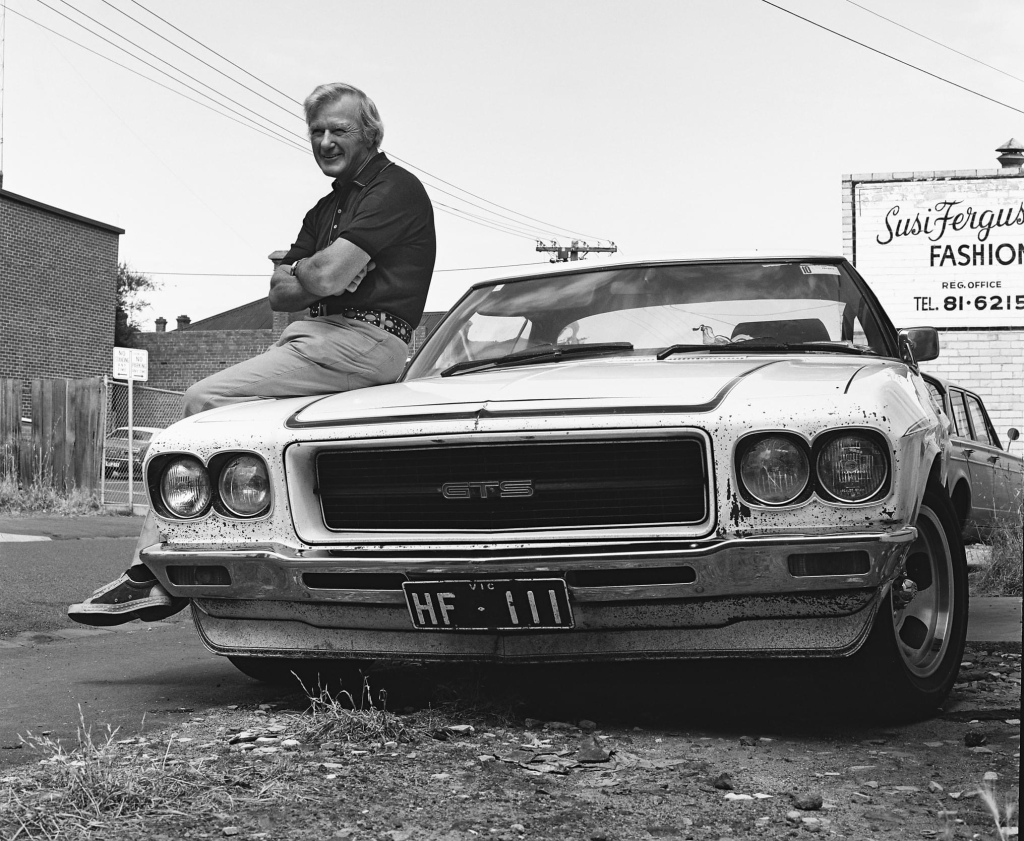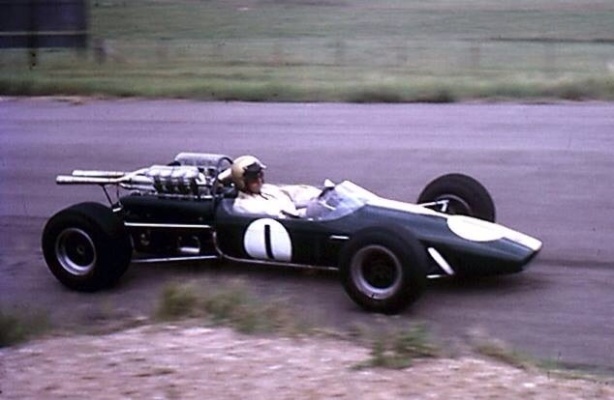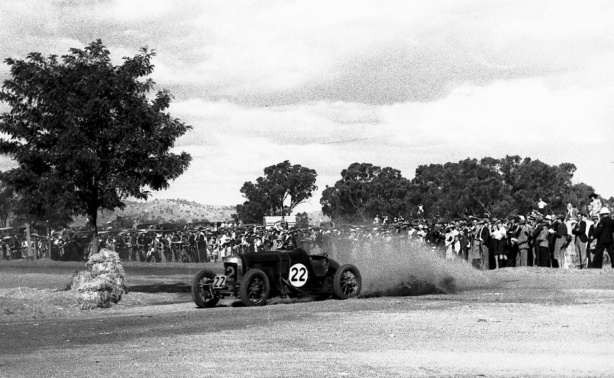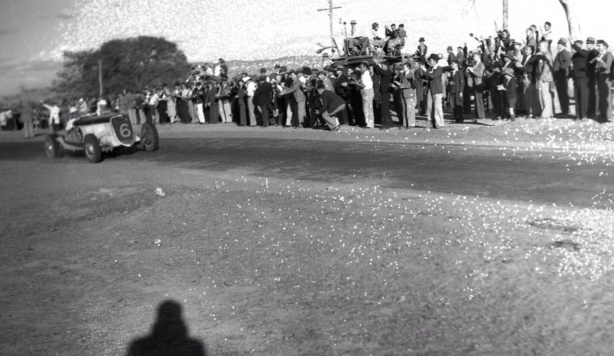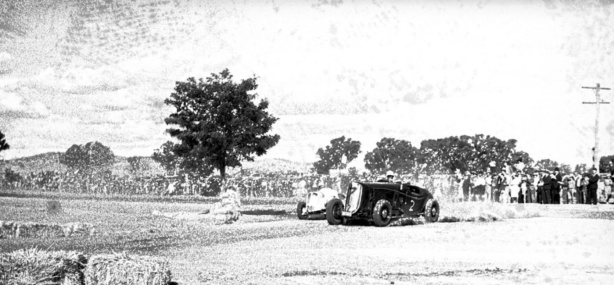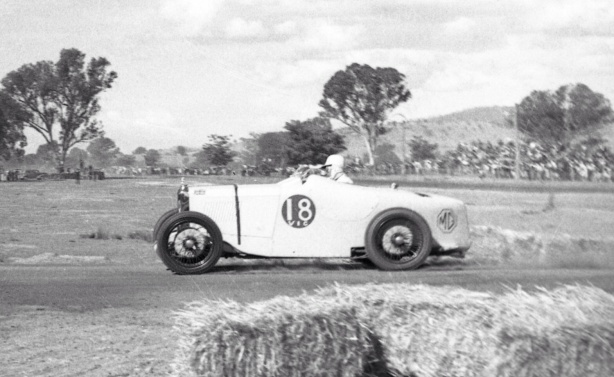
Most Australian enthusiasts are aware of the Lex Davison, Stan Jones and Tony Gaze assault on the 1953 Monte Carlo Rally in the first Holden 48-215…
In doing some research on Tony Gaze recently I came upon this snippet from the great fighter ace in an Eoin Young interview published in the June 1997 issue of MotorSport- it made me smile given my abiding interest and respect for these three highly competitive racers, rivals and friends.
‘We had a good run.
Before the final test I think we were in sixth place and then we had an argument.
Stan wanted me to drive the final test because he felt I was better on ice than Lex (highly likely given the length of time TG lived in Europe compared to the other two), but Lex said he had put all the money into it and was determined to drive that final stage (which would have been exactly my view if in that position!)
That did it. Stan sulked.’

Gaze, Davison and Stan all smiles after the finish at Monaco (SMH)
‘He was navigating and I was braced in the back with the stopwatches. I suppose Stan might have been feeling car sick but he wouldn’t read out the markers and we finally came in 64th out of 100 finishers. It was probably a good thing because if we had done well they (the scrutineers) would have torn the car apart. On the way back we stopped off at Monza and our best lap average with three up and all of our luggage was 5 mph faster than a standard Holden’s top speed!’
GMH Australia were so delighted that they gave Stan and Lex a Holden each as a bonus but Gaze never received so much as a thank-you note.
The enterprise was an amazing one given the logistics of the time, the cost (4000 pounds- four times the cost of a new Holden then), lack of support from General Motors Holden and the lack of European rallying experience of the intrepid pilots whilst noting their stature as racing drivers.
Jones had never driven on the continent before. The February 1953 MotorSport reported the trio delighted the European press by saying that they had never seen snow before- whilst that may have been true of Davison and Jones it would not have been the case for Gaze given his lengthy residence in the UK, a photo of him at Davos in Stewart Wilson’s biography of the man rather proves he was familiar with the white stuff!
Upon reflection, Jones grew up in Warrandyte and Lex lived at Lilydale, both places not too far from Mount Donna Buang where snow falls each year, so on balance we can conclude the above was PR bullshit!

Much was made at the time of the lack of rallying experience of all three but Davison and Jones had extensive trials experience- these events in an Australian context were typically of 100-200 miles duration, sometimes at night combining road navigation with sub-events which emphasised performance and car control.
In the all-rounder style of competition of the period keen racing types like Davison, Jones, Whiteford and Patterson contested trials, hillclimbs and circuit races. Indeed both Davison once, and Jones four times won the Light Car Club of Australia’s annual Cohen Trophy for best overall performance in the clubs trials.
‘Lex and Stan saw a lot of each other, since they were competing not only in the same trials but also the same hillclimbs and race meetings. The two were already great friends, and during 1952 this grew into an informal business relationship’ with Lex selling some cars through Stan’s car yards and splitting the profits with him Graham Howard wrote.
Peter Ward, friend and fettler of Lex’ cars engineered the two into sharing a Holden in the November 1952 Experts Trial, the pair finishing third with Ward navigating. Ward had proved the pair could co-exist in competition conditions- by mid 1952 Australian racer and AGP winner John Barraclough had secured two entries for the 1953 Monte- for himself and John Crouch and for Lex and Stan.
Tony, in the UK racing an Aston Martin DB3 that year, met Barraclough at London’s Steering Wheel Club and became the third member of the Lex/Stan crew. Gaze lodged all of the paperwork and later attended to getting the car through Customs.

Tony Gaze in his 2 litre F2/F1 ex-Moss HWM Alta during the 1952 German Grand Prix at the Nurburgring- Q14 and DNF gearbox on lap 6 in the race won by Alberto Ascari’s Ferrari 500. Ascari’s car was acquired by Tony in 1954 and raced successfully by both Gaze and then later Davison to two AGP wins. The car above is the HWM referred to later in the text- acquired by Lex and re-engined by his team in Templestowe to Jag XK120 ‘C Type’ spec it won the 1954 AGP and is still extant in Australia in sportscar form in the hands of the Hough family (LAT)
Graham Howard in Davison’s biography wrote that by the time the final decision was made to compete there were just two weeks before the car had to loaded aboard a freighter sailing from Port Melbourne on 25 November!
The intrepid Melbourne duo acquired a 1952 Holden 48-215 with 6000 miles on the clock which had been nicely run in by their friend and Repco Research boss Charlie Dean. Dean was a racer and engineer- the constructor of the Maybachs which Stan owned and raced but prepared by Repco. Dean was paid 550 pounds by each of Lex and Stan for the car.
With no interest or support from GMH (who had a waiting list for the cars at the time) the car was stripped, rebuilt and repainted in Dean’s home garage in Kew- not too far from Stan’s Superior Motors and Lex’s Paragon Shoes businesses in Abbotsford and Collingwood respectively.
Charlie was the ‘industry link man’ ‘…calling in many favours from many corners of the Melbourne motorsport world and the broader motor industry. Via his contacts through Repco, not only with Holden but also with component suppliers…A lot of people put in a lot of work into the sprint to get the Holden ready ready for Monte-Carlo- after all it was a marvellous adventure. But much more than that, it was a consciously Australian expedition into international territory, in the 1950’s spirit of optimism and confidence which led thousands of Australians overseas in search of fame and fortune’ wrote Graham Howard providing broader context outside motor racing itself.

The Monte Holden getting plenty of attention from Port Melbourne’s ‘wharfies’ at Station Pier. That’s Charlie Dean removing the Victorian ‘plates from the boot lid (Davison)
Some modifications to the cars were allowed by the organisers.
A Buick speedo which read in kilometres was dropped into the Holden binnacle, a ten gallon fuel tank was added, two driving lights were mounted on the bonnet and recessed fog lamps into the front guards below the headlights.
A heater-demister and windscreen washer was installed with the washer reservoir located next to the exhaust to keep it warm. An emergency electric fuel pump was mounted on the bulkhead with a change-over switch on the dash.
A ‘rug rail’ which ran between the B-Pillars behind the front seat back provided useful chassis stiffening.
Dean’s knowledge of the 2.2 litre, OHV, cast iron Holden six was pretty good by that stage- he fitted stronger con-rods, bigger ex-Buick valves ‘and an inlet manifold which had been carefully sliced in half, internally enlarged, then welded back together and returned to standard external appearance’ which gave a useful boost in power if not, perhaps (sic) in accordance with the letter of the rules.
By the time all of the luggage, spares, men and clobber was loaded up the six-cylinder sedan weighed 8 hundred-weight more than the 20 hundred-weight of the standard car.
Lex’ pride in Australia was clear in his post-event Australian Motor Sports magazine article; ‘It was considered that this car had to be an example of Australian workmanship, that nothing should be skimped, and no short cuts taken, as one of the main reasons for our making this journey was to endeavour to show that industrially, Australia has come of age, that we have an engineering industry, quite a capable one, and that we are no longer a country of aborigines and back country sheep herders’.
‘A kangaroo with Australia printed underneath was painted on either side of the bonnet and the word ‘Australia’ was printed on the bootlid in gold, given the new Registered Australian Racing Colours of green and gold’.
On January 1 1953 the car landed in the UK, whilst on the other side of the world Lex rolled his Alfa P3 at Port Wakefield, South Australia after a tyre failed- Lex was ok, discharged from hospital whilst Stan winning three races on the day aboard Maybach 1. On January 7 they were enroute to the UK.
In the meantime Tony Gaze had borrowed a Holden used as a development car by Lucas in the UK to get the feel of it. He then tested the rally car when it arrived and was suitable impressed with its performance despite the added weight relative to the standard machine. He diagnosed a better heating system was needed for the rear passenger and windscreen, this work was done.

Start of the event outside the Royal Automobile Club of Scotland, Blythswood Square, Glasgow (AGR)

(AGR)
Competitors came from over 20 different countries- they could choose to start from different cities in Europe including Glasgow, Stockholm, Oslo, Monte Carlo itself, Munich, Palermo and Lisbon.
The Holden began the rally in Glasgow on 20 January 1953- Glasgow cars travelled the 2100 mile route to Monte Carlo via Wales, London, Lilles, Brussels, Amsterdam, Paris and Clermont Ferrand in The Alps.
The first 3 days were driven non-stop through thick fog. In the Alps on thee fourth night the crew ‘encountered a nightmare of falling snow and icy roads’, the Australians reported. MotorSport on the other hand described the conditions as generally kind.
Lex and Stan were completely unprepared for the driving conditions and soon the crew decided to abandon the sleeping roster to make use of Tony’s skill in fast driving in fog.
In any event only Lex could manage sleep on the back seat set up to allow someone to lie sideways.
As they encountered ice later in the journey ‘Lex was pleased with the handling of the Holden, and was confidently using the frozen snow on the outside of the corners to help the car around.’
During Stan’s stint in the ice, a truck they were overtaking veered out and hit the side of the car inches from Lex’ sleeping head but he continued in deep-sleep bliss.
The fog disappeared before dawn but still with plenty of ice about, the risk was a mistake close to the finish.
440 cars entered the event- of the 404 which started, 253 reached Monte Carlo without loss of points, including the Holden.

The event shot ‘everybody has seen’ but nobody knows where it is- intrigued to know the answer (Pinterest)
They drove unpenalised under the finish banner in Monaco and were’…escorted to a large marquee on the Boulevard where we were offered drinks, and we stood beside the sea-wall sipping brandy, blinking in the sun. We were terribly tired, and I noticed that Tony was fast asleep standing up leaning against the sea-wall’ Howard quoted Davison.
Then came an acceleration and braking test- with Stan at the wheel the car was equal 9th- with Stirling Moss in a Sunbeam Talbot. The quickest time was 21.9 seconds, the Holden Sedan showed good performance amongst the top group which comprised in order; an Allard, Porsche, Jaguar, Ford V8, Sunbeam Talbot, Riley and two more Jags.

Jones attacks the Monaco acceleration and braking test (Davison)
As a result of this test 98 cars qualified for a final, eliminating, regularity test- clearly this 46 mile run over the Col de Braus above Monaco was the event the subject of debate amongst the three racers.
Distances between the controls had been announced in advance- a set speed through the six controls was to be drawn early on the Sunday morning.
The experienced crews knew the regularity route the Australians did not, nor did they have a spare car as many others did to practise it. Late in the day they were able to do do one lap in a VW as passengers.
The troubles which Gaze reflected upon at the beginning of this piece were similar to those documented by Howard in Davison’s biography- ‘that Stan “went on strike”, and for at least part of the test could not be bothered calling out distances. It would have been a typically Stan Jones flare-up, gone as quickly as it arrived, because there were also sections of the test where Stan was sitting sideways and using his feet to hold Lex in place as the Holden hurried around the endless hairpin corners’.
By the end of the test the team were sure they had got several sections close to perfect and others very wrong.
The results were announced at 9 o’clock that night- 64th place, and much better than they had feared. The result was still admirable and polished both the reputations of the drivers and a car not exactly built with European conditions in mind.

(AGR)
The rally was won by the Maurice Gatsonides/Peter Worledge Ford Zephyr from the Ian and Pat Appleyard Jaguar Mk7 and Roger Marian/Jean Charmasson Panhard Dyna X86. Gatsonides had spent four weeks ‘holidays’ lapping the Col de Braus loop, in contrast to the Australians!
Picking up the speed of the Holden ‘People’ wrote ‘They had certainly not run out of steam, for immediately after the rally they took the Holden to Monza where its lap speed was 73 mph and its maximum 90 mph which was impressive as road tests of the day put the cars maximum at 81 mph…the checking from stem to stern that was carried out must have included some skilful tuning’.
Davison and his friends also visited Alfa Romeo whilst in Northern Italy ‘…where Guidotti, having many years before driven Lex’s Alfas, now drove the Holden. Bacciagaluppi, manager of the Monza motor racing circuit and one of Tony’s many European racing contacts, helped them to get the rally car onto the track, where, three up, they averaged a higher lap speed than the road-tested maximum for a standard Holden’.

(AGR)
They drove back through Switzerland to England, where Gaze shipped the car back to Australia with some of the spare parts for the ex-Moss/Gaze HWM Lex acquired prior to leaving Europe.
Davo put the HWM Jaguar to good use, winning the 1954 Australian Grand Prix in it at Southport on Queensland’s Gold Coast. It was the first of Davo’s AGP wins- his good mate Jones had the race ‘in the bag’ before catastrophic chassis failure (welds) pitched Stanley through the local topography at a million miles an hour- it was a very lucky escape for him which totally destroyed Maybach 2.
‘Autosport published two photographs of the Holden, one showing it looking immaculate in Monte Carlo after the event, and commented “The Holden, although not a prize winner, impressed everyone with its performance. It has distinct possibilities as a rally car”.
As Gaze commented early on, GMH invited Lex and Stan (later to become Holden dealers as ‘Monte Carlo Motors on the corner of Punt and Swan Street, Richmond, Melbourne) to a luncheon at Fsihermans Bend (Holden HQ) where they were each given a new Holden FJ and a cheque to cover some of their outgoings- with Tony apparently forgotten.
There was enormous local press both during and after the event with Lex also doing extensive speeches and presesntations about the adventure to car clubs but mainly community groups upon their return. It was a very big deal indeed.
The Monte Holden’s competitive life extended into 1953 when Lex and Diana Davison- DD a very capable and experienced racer herself contested ‘The Sun’ Four Day Rally out of Melbourne, Lex won outright defeating 122 other cars in a new Holden shared with Peter Ward and Diana was second in the womens section of the event in the Monte car she shared with Pat Wilson.
The Monte Holden was used in several trials by Lex and Peter Ward including one in mid 1953 when Lex slid off the a hillside and knocked over a telephone pole- damage was mitigated by the aged rotten nature of the obstacle!

(Davison)
Peter Ward later bought it and used it on the road. ‘It had some vertical cracks in the firewall which puzzled the Holden engineers, but it gave no trouble, Peter drove it for eighteen months before selling the well travelled car for 750 pounds- it cost him 500.
I wonder what became of this car which really should have found its way into a GMH Collection!?
The first of the Redex Round Australia Trials commenced in 1953- a story for another time, no doubt Holden’s confidence in going into these events ‘boots and all’ was as a consequence of the trail-blazers- Davison, Jones and Gaze.
Etcetera…
Article on the Holden 48-215; https://primotipo.com/2018/12/06/general-motors-holden-formative/

(AGR)
Davo on the Monaco quayside. Without his drive and entrepreneurial skill, not to say resources, the assault would not have taken place- not that the other two fellas involved were exactly skint.

(AGR)
Tony Gaze would have been razor sharp in 1953- he raced his HWM Alta in both championship and non-championship events throughout Europe in 1952, his primary program in 1953 aboard an Aston DB3 sportscar. He started racing the Ferrari 500/625 so important in his and Lex’ career in 1954.

(AGR)
Credits…
‘Lex Davison: Larger Than Life’ Graham Howard, ‘Almost Unknown: Tony Gaze’ Stewart Wilson, ‘Me and My Holden: A Nostalgia Trip With The Early Holdens’ Don Loffler, ‘GMH People’, ‘AGR’- anygivenreason.com for many of the images, Pinterest, ‘SMH’ Sydney Morning Herald
Tailpiece: Port Melbourne to Monaco- after the finish…

(AGR)
Finito…










